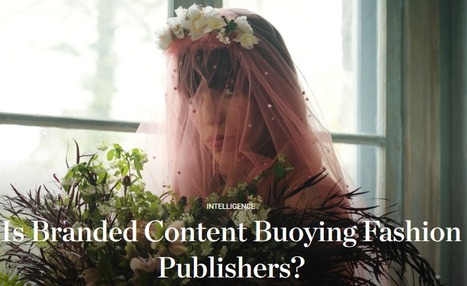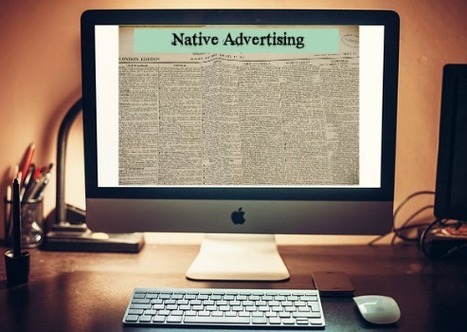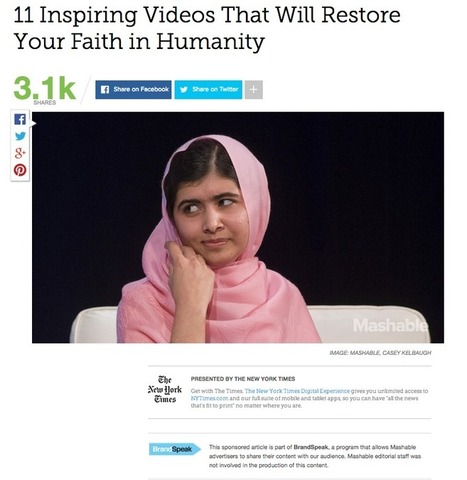 Your new post is loading...
 Your new post is loading...
Polar tested different ad formats including image-based content (graphics, image galleries, and slide shows), article-based content, and video-based content. It tested more than 30 pieces of content, with each type tested by a minimum of 1,000 people via desktop, mobile, and both. Among the findings of the study, conducted in March 2017: --Consumer awareness of a brand increased to 69% after engaging with branded content, while purchase intent was 51%. The study also used a control group with no branding. --Incorporating companion display ads next to branded content improved purchase intent by 17% and didn’t have a negative impact on brand perception --Imagery (infographics, image galleries, and slide shows) performed the best among content formats. And notably, video isn’t always needed to tell the story. However, imagery outperformed articles by 11%. "We found that consumers responded a bit more favorably when there was less obvious branding,” Bella said....
I've lived and breathed and thought about this space every single day, and here's the sad conclusion I've arrived at: digital display advertising doesn't work.
I think it's safe to say that digital display advertising has never lived up to the promise and the hype. Since the very beginning, advertisers have been obsessed with finding ways to get people to click on their ads. They've worked with an array of ad creation platforms and embraced programmatic methods so that the right ads get in front of the right people, and yet the click-through average across all platforms and methodologies is .06 percent.
This means that for every 1,000 times an ad is shown, it is clicked on only .6 times. This means that for the average digital display campaign to get a single click, it needs to be served 1,800 times....
Therefore, content creators and advertisers may find themselves scratching their heads about how to break through the clutter with compelling branded content that attracts an audience and makes them want more. “While there’s no ‘one size fits all’ when it comes to creating impactful branded content, we’ve identified some common themes in our research and content testing that can be used as best practices for making content resonate with audiences,” said Harry Brisson, Director of Lab Research at Nielsen. To better understand how consumers are reacting to this new form of marketing content, Nielsen assessed consumer reactions to more than 100 pieces of branded content and found that a brand’s effectiveness (e.g., how a brand resonates with viewers) is largely affected by the format and environment the message is delivered in. The results of the analysis uncovered three key takeaways that can help brands deliver strong content that resonates with and builds audiences: - Branded content can drive higher brand recall and brand lift than pre-roll - When viewers enjoy content, they view the integrated brands more favorably - Partnering with a publisher can drive ad impact....
On Monday, Gucci will release its latest fashion film, a Gia Coppola-directed spin on the tragic Greek love story of Orpheus and Eurydice, set in present-day New York City and starring Lou Doillon, Marcel Castenmiller, Laura Love, Rocco Di Gregorio, among others. Coppola and stylist Arianne Phillips worked in tandem with Alessandro Michele to capture the dreamy feel of the hot-shot creative director’s Pre-Fall 2016 collection, which the film — shot across five locations and broken into four episodes — was created to promote. Michele even designed a custom pink 10-foot long wedding veil for Doillon’s character.
But while shorts like these are nothing new, the genesis of the film was fairly unorthodox. Instead of tapping its internal marketing team or a traditional agency, Gucci worked with 23 Stories, the branded-content studio launched in January 2015 by publishing giant Condé Nast. Beyond Gucci’s own marketing channels, the film will be distributed through six Condé Nast (US) properties — Vogue, GQ, the New Yorker, W, Vanity Fair and Pitchfork — which, together, attracted a total of about 32 million unique visitors in April 2016, according to Comscore. Beyond their URLs, those six publications boast a cumulative social media following of nearly 67 million. The film will also be promoted via Vogue China and Vogue Japan. Gucci and Condé Nast suggest the project is bigger and more ambitious than anything else either party has previously done in the branded-content space, both in terms of the level of talent recruited and also the scale of the production.
To be sure, the Kering-owned Italian luxury house has the resources and capacity to create video content like this on its own. But Gucci is after Condé Nast’s larger, and presumably more diverse, audience. For instance, Gucci has 8.8 million followers on Instagram while these six titles combined have about 18.5 million. In this deal, Pitchfork’s millennial male followers — an important demographic for Gucci under Michele — are as crucial to the equation as W’s affluent luxury consumer....
Eagle-eyed readers may notice a new feature here on Re/code today. It’s called “Sponsor Content,” and is, for us, a new form of advertising. Known broadly as “native advertising,” this is a category of ad that takes the form of an article written by, or commissioned by, an advertiser. It’s widely used online, but the technique actually goes back well before the Web, when print publications ran articles written by advertisers that were called “advertorials.”
Some websites might try to present these ads as if they were normal posts written by their reporters, editors, or curated guest contributors. We won’t be doing that. You’ll notice that we clearly label them “Sponsor Content” with a blue label instead of our usual black one. We also use the company logo next to the writer’s byline, and, at the bottom of each such post, include a disclosure statement saying that the article is a form of advertising, and was neither written by, nor edited by, our journalists.
That doesn’t mean these pieces are bad, or unworthy of your time. It doesn’t mean we are embarrassed to post them. In fact, we hope you will find them interesting. It just means we want to keep faith with you by making things clear.
Earlier this week, Coca-Cola declared the corporate website dead.
Take one quick look at their new corporate website and I think you will see an example of the future of quality content marketing. They are clearly displaying how the art of storytelling not only can influence our preference for a brand or product, but surely their intent is to also reach a search engine position of respect and power....
|
In September of 2013, the late David Carr, skeptical of the burgeoning native advertising tactic that was back then “all the rage,” wrote a column titled “Storytelling Ads May Be Journalism’s New Peril.” Three months later, the Times jumped into the fray. Today the company boasts a fully-fledged content marketing arm, T Brand Studio. Adam Aston, vice president and executive editorial director of the Studio, said when it was first launched, there was a sense of anxiety among the Times’ newsroom, as well as advertisers, that the content they created wouldn’t be up to par with its editorial content. “We were really mindful from inception to approach it as fact-first, narrative-first, with a strong story, strong characters,” he said at a recent panel event, hosted by MediaRadar in New York City, about the future of native advertising. “From inception, whether we were making the simplest stories we could three or four years ago, to today, where a lot of what we’re making is a three-ring circus of interactivity, like VR and AR, we’re still driven by the same thought that the story, the quality of the reporting, finding authentic people, much in the way that our newsroom inspires readers – we want to do the same thing.” Here are five tips from the panelists for using native advertising....
The nonprofit Online Trust Alliance (OTA) on Wednesday conducted a study that found 71% of native ads on top media sites fail to offer adequate labeling, transparency, and complete consumer disclosure.
This is a blow to the native ad/branded content business and should be a wake-up call for publishers and content studios.
The study, an analysis of native ads on the top 100 news websites, found that 71% earned failing scores for disclosures, delineation, and discoverability. The bottom line: The sites didn’t offer consumers the ability to easily discern pure editorial from ads.
As most readers of this column know, native advertising refers to Web site content that’s funded and produced outside the publisher’s editorial review or influence, yet is designed to appear similar to editorial on that site. As the OTA mentions, “this illustrates the tension -- paid for and controlled separately, but presented in a way to appear as editorial. The potential for audience confusion or misinterpretation is obvious, and the rapid rise in the deployment of native has already prompted concerns from advocates, media and regulators.”...
“While the industry looks at native advertising as the holy grail to drive new revenues, they are failing to address the long-term issue. With 71% of native ads failing to pass the consumer transparency acid test, this report should be a wake-up call to the industry. Inaction is not an option. Conversely, providing these concrete examples and recommendations helps advertisers, networks and publishers in moving forward,” Craig Spiezle, executive director at the Online Trust Alliance, told Native Insider via email.
Have you been thinking about turning your organization's communications into your version of a metropolitan newspaper newsroom? Here are some examples you should look at.
Those 11 inspiring videos are all original feel-good New York Times productions, and as Digiday’s Lucia Moses noted this morning, the ad is intended to drive subscription signups forThe Times, with a prominent call to action at the top of the piece imploring readers to “Get with The Times.
”While this may seem bizarre and a little too meta for this early in the morning, it’s actually a shrewd move by The Times to grow their audience. Clearly, they’ve identified Mashable readers as potential Times readers and subscribers, and as a result, they’ve come to them with a month-long campaign of branded posts._
The Times also punched up the titles of the individual videos for a Mashable audience. “Tattoo Artist Gives Breast Cancer Survivors Nipples and Hope” was originally titled “The Nipple Artist,” and “Can Your Grandma Pump Iron Like This?” was called “Shirley and the Bodybuilder.”...
...As the traditional journalism business continues to implode, journalism educators need to be thinking a lot more about the second category, but also in broader ways about the first. If we recognize journalism in places where we never used to acknowledge its existence, journalism programs will discover niches that could fuel new programs and attract new students.
Here’s one: In 2009, I suggested that some advocacy organizations were creating “almost-journalism” — doing deep and valuable reporting on issues that mattered, such as civil liberties, human rights and more. They could do even better, I said, if they applied basic journalistic principles — because they’d be even more credible.
|



 Your new post is loading...
Your new post is loading...



















Does branded content really work? Research says yes and that's great news for marketing.